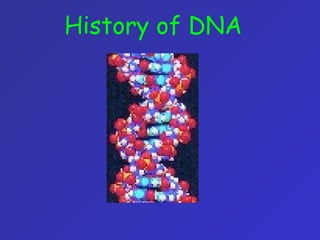Discovery dna
•Als PPT, PDF herunterladen•
8 gefällt mir•6,293 views
Discovery of DNA
Melden
Teilen
Melden
Teilen

Empfohlen
Empfohlen
Weitere ähnliche Inhalte
Was ist angesagt?
Was ist angesagt? (20)
Discovery of dna as the universal genetic material

Discovery of dna as the universal genetic material
Andere mochten auch
Andere mochten auch (20)
Ähnlich wie Discovery dna
Ähnlich wie Discovery dna (20)
Week 6 Assignment 2From your course textbook Case Workbook to Ac.docx

Week 6 Assignment 2From your course textbook Case Workbook to Ac.docx
MOLECULAR BASIS OF INHERITANCE -DNA AS GENETIC MATERIAL

MOLECULAR BASIS OF INHERITANCE -DNA AS GENETIC MATERIAL
RCISE Friedrich her showed in 1868 that chromosomes could be broken d.pdf

RCISE Friedrich her showed in 1868 that chromosomes could be broken d.pdf
Mehr von vjcummins
Mehr von vjcummins (20)
Kürzlich hochgeladen
Mehran University Newsletter is a Quarterly Publication from Public Relations OfficeMehran University Newsletter Vol-X, Issue-I, 2024

Mehran University Newsletter Vol-X, Issue-I, 2024Mehran University of Engineering & Technology, Jamshoro
https://app.box.com/s/7hlvjxjalkrik7fb082xx3jk7xd7liz3TỔNG ÔN TẬP THI VÀO LỚP 10 MÔN TIẾNG ANH NĂM HỌC 2023 - 2024 CÓ ĐÁP ÁN (NGỮ Â...

TỔNG ÔN TẬP THI VÀO LỚP 10 MÔN TIẾNG ANH NĂM HỌC 2023 - 2024 CÓ ĐÁP ÁN (NGỮ Â...Nguyen Thanh Tu Collection
Kürzlich hochgeladen (20)
ICT Role in 21st Century Education & its Challenges.pptx

ICT Role in 21st Century Education & its Challenges.pptx
Food safety_Challenges food safety laboratories_.pdf

Food safety_Challenges food safety laboratories_.pdf
UGC NET Paper 1 Mathematical Reasoning & Aptitude.pdf

UGC NET Paper 1 Mathematical Reasoning & Aptitude.pdf
Vishram Singh - Textbook of Anatomy Upper Limb and Thorax.. Volume 1 (1).pdf

Vishram Singh - Textbook of Anatomy Upper Limb and Thorax.. Volume 1 (1).pdf
HMCS Max Bernays Pre-Deployment Brief (May 2024).pptx

HMCS Max Bernays Pre-Deployment Brief (May 2024).pptx
TỔNG ÔN TẬP THI VÀO LỚP 10 MÔN TIẾNG ANH NĂM HỌC 2023 - 2024 CÓ ĐÁP ÁN (NGỮ Â...

TỔNG ÔN TẬP THI VÀO LỚP 10 MÔN TIẾNG ANH NĂM HỌC 2023 - 2024 CÓ ĐÁP ÁN (NGỮ Â...
Unit-V; Pricing (Pharma Marketing Management).pptx

Unit-V; Pricing (Pharma Marketing Management).pptx
Discovery dna
- 2. How do genes work? How do genes determine the characteristics of an organism? Are genes single molecules? Are genes made up of many molecules?
- 3. In the 1900’s biologists were trying to find these answers. In order to understand genetics, biologists had to figure out the chemical structure of a gene. (what are the parts & pieces?)
- 4. Friedrich Meischer – 1870’s First to isolate DNA
- 5. Frederick Griffith - 1928 -Studied two types of bacteria (smooth/rough) -cause of pneumonia (lung disease)
- 6. Type 2- (Rough looking) •Rough looking (non-encapsulated) •When injected harmless Type 1- (smooth looking) •Smooth looking (encapsulated) •Disease causing •Killed mice
- 7. Experiment # 1 Does the disease causing bacteria produce a poison? Heat Killed disease causing bacteria (smooth) Mouse LivedInjected into the mouse Summary: The mouse lived, this suggests that disease causing bacteria (smooth) does not release a chemical poison.
- 8. Heat Killed disease causing (smooth) Bacteria + live harmless (rough) bacteria Injected into the mouse Experiment # 2 Summary: By themselves neither should of made the mice sick, however, many of the mice got pneumonia and died. The lungs of the mice were filled with the disease causing bacteria. DEAD
- 9. These experiments showed that one strain of bacteria could be transformed into another type of bacteria. Griffith’s Conclusion Griffith hypothesized that when the live, harmless bacteria and heat killed bacteria were mixed, some factor was transferred from the heat killed cells into the live harmless cells. This factor may contain “information” that could transform the harmless bacteria. This was the first evidence that DNA stores and transmits genetic information.
- 10. Oswald Avery - 1944 Oswald Avery led a group of scientists to further investigate the work of Griffith. They wanted find out which molecule in the heat killed bacteria was the most important for transformation.
- 11. Summary: Discovered that DNA stores and transmits the genetic information from one generation of organisms to the next generation. (DNA)
- 12. Edwin Chargaff – 1947 Studied DNA in various species Nitrogen bases are proportionate within a species Ratio of bases are various between species •Adenine and Thymine were found in proportionate amounts •Cytosine and Guanine were found in proportionate amounts Chargaff’s Rules
- 13. Alfred Hershey and Martha Chase -1952 Their experiments concluded that the genetic material of the bacteriphage was DNA and not protein.
- 14. Rosalind Franklin & Maurice Wilkins Early 1950’s
- 15. X-ray diffraction showed •DNA fibers had a twisted pattern •Large groups of molecules in the fibers were spaced out in equal intervals
- 16. James Watson & Francis Crick - 1953 •Watson Crick Model •“Double Helix” •Determined the shape and structure •Adenine bonds with Thymine •Cytosine bonds with Guanine
- 18. The End